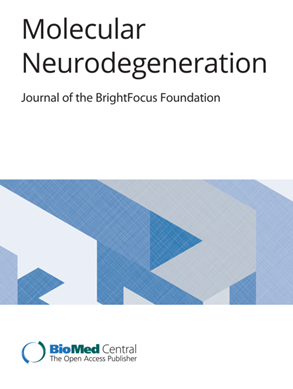TMEM106B水平升高导致溶酶体功能障碍,影响突触信号传导和神经元健康
IF 17.5
1区 医学
Q1 NEUROSCIENCES
引用次数: 0
摘要
已知跨膜蛋白106B(TMEM106B)的基因变异会影响多种神经退行性疾病的风险和表现,并改变健康老龄化。虽然人类研究的证据表明,风险等位基因与较高水平的 TMEM106B 有关,但尚未评估 TMEM106B 水平升高对神经退行性疾病和衰老的影响,目前仍不清楚 TMEM106B 如何调节疾病风险。为了研究 TMEM106B 水平升高的影响,我们产生了表达人类野生型 TMEM106B 的 Cre 诱导型转基因小鼠。我们使用体外和体内检测方法评估了溶酶体和神经元的健康状况,包括透射电子显微镜、免疫染色、行为测试、电生理学和大量 RNA 测序。我们创建了第一个成功过表达 TMEM106B 的转基因小鼠模型,杂合子(hTMEM106B(+))和同源杂合子(hTMEM106B(++))动物的 TMEM106B 蛋白水平分别增加了 4 到 8 倍。我们的研究表明,TMEM106B蛋白水平的增加会诱发溶酶体功能障碍以及与神经元可塑性、学习和记忆相关基因的年龄相关性下调。TMEM106B水平的增加导致12月龄动物的突触信号转导发生改变,并进一步表现出焦虑样表型。最后,我们在 21 个月大的动物海马中观察到了轻微的神经元缺失。第一个过表达 TMEM106B 的转基因小鼠模型的特征表明,较高水平的 TMEM106B 会改变大脑的衰老,损害大脑对神经退行性疾病病理机制的恢复能力,从而对大脑健康产生负面影响。这种新型模型将成为研究 TMEM106B 水平升高对衰老的参与和贡献的宝贵工具,对于研究许多与年龄有关的疾病也至关重要,因为 TMEM106B 在遗传学上被证明是一种疾病和风险调节因子。本文章由计算机程序翻译,如有差异,请以英文原文为准。
Increased TMEM106B levels lead to lysosomal dysfunction which affects synaptic signaling and neuronal health
Genetic variation in Transmembrane protein 106B (TMEM106B) is known to influence the risk and presentation in several neurodegenerative diseases and modifies healthy aging. While evidence from human studies suggests that the risk allele is associated with higher levels of TMEM106B, the contribution of elevated levels of TMEM106B to neurodegeneration and aging has not been assessed and it remains unclear how TMEM106B modulates disease risk. To study the effect of increased TMEM106B levels, we generated Cre-inducible transgenic mice expressing human wild-type TMEM106B. We evaluated lysosomal and neuronal health using in vitro and in vivo assays including transmission electron microscopy, immunostainings, behavioral testing, electrophysiology, and bulk RNA sequencing. We created the first transgenic mouse model that successfully overexpresses TMEM106B, with a 4- to 8-fold increase in TMEM106B protein levels in heterozygous (hTMEM106B(+)) and homozygous (hTMEM106B(++)) animals, respectively. We showed that the increase in TMEM106B protein levels induced lysosomal dysfunction and age-related downregulation of genes associated with neuronal plasticity, learning, and memory. Increased TMEM106B levels led to altered synaptic signaling in 12-month-old animals which further exhibited an anxiety-like phenotype. Finally, we observed mild neuronal loss in the hippocampus of 21-month-old animals. Characterization of the first transgenic mouse model that overexpresses TMEM106B suggests that higher levels of TMEM106B negatively impacts brain health by modifying brain aging and impairing the resilience of the brain to the pathomechanisms of neurodegenerative disorders. This novel model will be a valuable tool to study the involvement and contribution of increased TMEM106B levels to aging and will be essential to study the many age-related diseases in which TMEM106B was genetically shown to be a disease- and risk-modifier.
求助全文
通过发布文献求助,成功后即可免费获取论文全文。
去求助
来源期刊

Molecular Neurodegeneration
医学-神经科学
CiteScore
23.00
自引率
4.60%
发文量
78
审稿时长
6-12 weeks
期刊介绍:
Molecular Neurodegeneration, an open-access, peer-reviewed journal, comprehensively covers neurodegeneration research at the molecular and cellular levels.
Neurodegenerative diseases, such as Alzheimer's, Parkinson's, Huntington's, and prion diseases, fall under its purview. These disorders, often linked to advanced aging and characterized by varying degrees of dementia, pose a significant public health concern with the growing aging population. Recent strides in understanding the molecular and cellular mechanisms of these neurodegenerative disorders offer valuable insights into their pathogenesis.
 求助内容:
求助内容: 应助结果提醒方式:
应助结果提醒方式:


